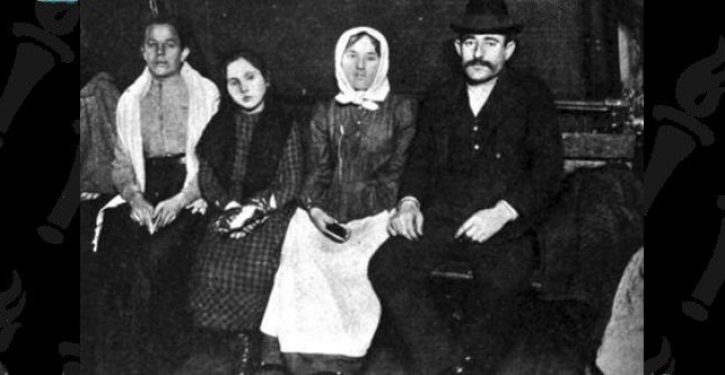
“From Dreamers to asylum-seekers to Green Card holders, the president’s policies have provoked anxiety and heartache for immigrants at every step.” So reads the teaser of a piece that ran in Rolling Stone in March. The article proper hints at the wave of nostalgia among some liberals who long for the simpler times when our ancestors made their way to the New World aboard ship and caught that initial glimpse of Lady Liberty welcoming all.
The article even reconstructs the experience of Donald Trump’s grandfather, Friedrich Trumpf, as he “sailed into New York Harbor from Germany” in 1885:
Ellis Island had not yet opened. There was no federal immigration department and no border patrol. Visitors were not expected to carry passports or visas. To most Americans, the notion of an “illegal immigrant” would have elicited confusion. Young Trumpf likely faced a cursory examination to make sure he was not a “convict, lunatic, idiot.” Then his name and age were recorded in a handwritten ledger along with his “calling”: “none.”
Rolling Stone directs plenty of animus at Friedrich Trumpf’s ruthless grandson, who it insists has converted the experience of incoming migrants (meaning illegals who attempt to sneak across the southern border) into an unfathomable, nightmarish labyrinth of cages and interrogations by strict government martinets.
Will this presidential election be the most important in American history?
Another wistful article, this one from the New York Times in February, laments: “The federal agency that issues green cards and grants citizenship to people from foreign countries has stopped characterizing the United States as ‘a nation of immigrants.’”
The problem with looking backward to a more civil time in the annals of U.S. immigration is that to do so is to engage in myth. Even the Statue of Liberty as “a monument to immigration” is a bit of fiction:
… [T]he Statue of Liberty … is a gift from France to honor the centennial of American independence. Emma Lazarus’ “Give me your tired…” — a cri-de-coeur against Russian pogroms — is a later add-on. E pluribus unum explicitly commemorates the union of thirteen British colonies into one nation. The statue and the motto do not celebrate immigration; they salute the achievement of the settlers who founded those colonies and, in time, won independence from their Mother Country. It was the settlers’ nation, not empty wilderness, that later gave immigrants a new home.
And what of Ellis Island? According to an archived document written in 1903 by Dr. Allan McLaughlin, U. S. Public Health and Marine Hospital Service, the inspection of immigrants to the U.S. began with the steamship line in the would-be passenger’s native country:
This makes the agent examine the applicants for tickets, and probably quite a large number of defectives[!] are refused passage by agents of the first-class lines. These defectives then usually try some less particular and smaller lines and take chances of escaping inspection at the Canadian or Mexican borders.
Even then! Who would have guessed it?
The next scrutiny to which the immigrant is subjected is that of the steamship authorities at the port of embarkation. This was formerly a perfunctory examination, and is so still, as far as some lines are concerned, but first-class lines, notably the English and German, examine the immigrants carefully and with due regard for our laws.
The strict enforcement of our laws, and especially the imposition of one hundred dollars fine for bringing to our ports any ease [sic: disease] of a contagious character, have occasioned some improvement in the inspection made by ships’ doctors at European ports.
Once having made port, inspectors with the the state quarantine authorities would board the ship and inspect the immigrants for quarantinable disease, such as cholera, small-pox, typhus fever, yellow fever or plague.
Applicants who were deemed safe to come ashore were required to ask questions, which included:
- The full name, age, and sex;
- whether married or single;
- the calling or occupation;
- whether able to read or write;
- the nationality;
- the race;
- the last residence;
- the seaport of landing in the United States;
- the final destination, if any, beyond the port of landing;
- whether having a ticket through to such final destination;
- whether the alien has paid his own passage, or whether it has been paid by any other person or by any corporation, society, municipality, or government, and if so, by whom;
- whether in possession of thirty dollars, and if less, how much;
- whether going to join a relative or friend and if so, what relative or friend, and his name and complete address;
- whether ever before in the United States, and if so, when and where;
- whether ever in prison or almshouse or an institution or hospital for the care and treatment of the insane or supported by charity;
- whether a polygamist;
- whether an anarchist;
- whether coming by reason of any offer, solicitation, promise or agreement, expressed or implied, to perform labor in the United States, and
- what is the alien’s condition of health, mental and physical, and whether deformed or crippled, and if so, for how long and from what cause.
Those who answered the questions satisfactorily would next be subject to a complete medical examination. The writer includes this caveat for government physicians:
The medical examiners must ever be on the alert for deception. The nonchalant individual with an overcoat on his arm is probably concealing an artificial arm; the child strapped to its mother’s back, and who appears old enough to walk alone, may be unable to walk because of infantile paralysis; a case of favus [skin infection] may be so skillfully prepared for inspection that close scrutiny is required to detect the evidences of recent cleansing, and a bad case of trachoma [a contagious bacterial infection of the eye] may show no external evidence and be detected only upon inverting the eyelid.
After the last alien in line has passed the doctor, the suspected ones turned aside are thoroughly examined, idiots and those suffering with a loathsome or dangerous contagious disease are certified and sent to the board of special inquiry.
The board would make the determination on whether the applicant would be allowed to continue ahead or face deportation. For those certified for deportation, “the law is mandatory, and the medical certificate is equivalent to exclusion, the board simply applying the legal process necessary for deportation.”
No trial beyond this hearing would be conducted.
By comparison with today’s methods of processing illegal aliens, the procedures for legal immigration in the “good old days” were far more draconian. The same risks of the spread of contagion exist today and are mitigated largely through the efforts of the border patrol, which intercepts illegals attempting to enter the United States.
These are the same agents whose jobs liberals want to abolish.




